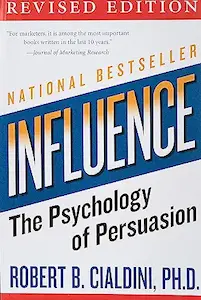Influence - Summary
Robert B. Cialdini

Introduction
Influence: The Psychology of Persuasion, written by Robert B. Cialdini, is a groundbreaking book that explores the science behind why people say “yes” and how to apply these principles in everyday life. Cialdini, a renowned social psychologist, draws on his extensive research to explain the six universal principles of influence that can be used to persuade others to take action.
Reciprocation
The first principle of influence is reciprocation. This principle is based on the idea that people feel obligated to repay others for what they have received. Cialdini provides several examples of how reciprocation can be used in everyday life. For instance, a waiter who gives a mint with the check can increase the tip by 3%. Similarly, a charity that sends personalized address labels to potential donors can increase the response rate by 18%.
Commitment and Consistency
The second principle of influence is commitment and consistency. This principle is based on the idea that people like to be consistent with what they have previously said or done. Cialdini provides an example of how this principle can be used in sales. A salesperson who gets a potential customer to make a small commitment, such as filling out a survey, is more likely to get them to make a larger commitment, such as purchasing a product.
Social Proof
The third principle of influence is social proof. This principle is based on the idea that people look to others to determine what is correct or appropriate behavior. Cialdini provides several examples of how social proof can be used in advertising. For instance, a company can use testimonials from satisfied customers to persuade potential customers to buy their product.
Liking
The fourth principle of influence is liking. This principle is based on the idea that people are more likely to say “yes” to someone they like. Cialdini provides an example of how this principle can be used in job interviews. A job candidate who shares a common interest with the interviewer is more likely to get the job.
Authority
The fifth principle of influence is authority. This principle is based on the idea that people are more likely to follow the advice of someone who is perceived as an authority figure. Cialdini provides several examples of how authority can be used in advertising. For instance, a company can use a doctor or scientist to endorse their product.
Scarcity
The sixth and final principle of influence is scarcity. This principle is based on the idea that people value things more when they are scarce. Cialdini provides an example of how scarcity can be used in sales. A salesperson who tells a potential customer that a product is in short supply is more likely to get them to make a purchase.
Conclusion
Influence: The Psychology of Persuasion is a must-read for anyone who wants to understand the science behind why people say “yes.” Cialdini’s six universal principles of influence provide a roadmap for how to persuade others to take action. By understanding these principles, individuals can become more effective communicators, salespeople, and leaders. Whether you are a marketer looking to increase sales or a parent trying to get your child to do their homework, Influence provides valuable insights into the art of persuasion.